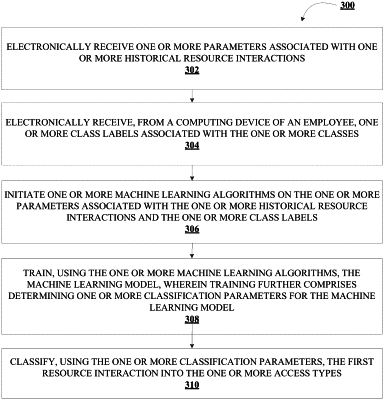| CPC H04L 63/102 (2013.01) [G06F 18/24 (2023.01); G06N 20/00 (2019.01); H04L 63/1441 (2013.01); H04L 63/20 (2013.01)] | 17 Claims |

|
1. A system for detection and classification of intrusion using machine learning techniques, the system comprising:
at least one non-transitory storage device comprising program instructions stored thereon; and
at least one processing device coupled to the at least one non-transitory storage device, wherein the program instructions are configured to cause the at least one processing device to perform the following operations:
electronically receive, from a computing device of a user, an indication that the user has initiated a first resource interaction;
retrieve information associated with the first resource interaction, wherein the information comprises at least one or more parameters associated with the first resource interaction;
initiate a machine learning model on the one or more parameters associated with the first resource interaction, wherein the machine learning module is trained by: retrieving one or more parameters associated with one or more historical resource interactions and one or more class labels associated with one or more classes; initiating one or more machine learning algorithms on the one or more parameters associated with the one or more historical resource interactions and the one or more class labels; and training, using the one or more machine learning algorithms, the machine learning model, wherein training comprises determining one or more classification parameters for the machine learning model; and
classify, using the machine learning model, the first resource interaction into the one or more classes, wherein the one or more classes comprises one or more access types.
|